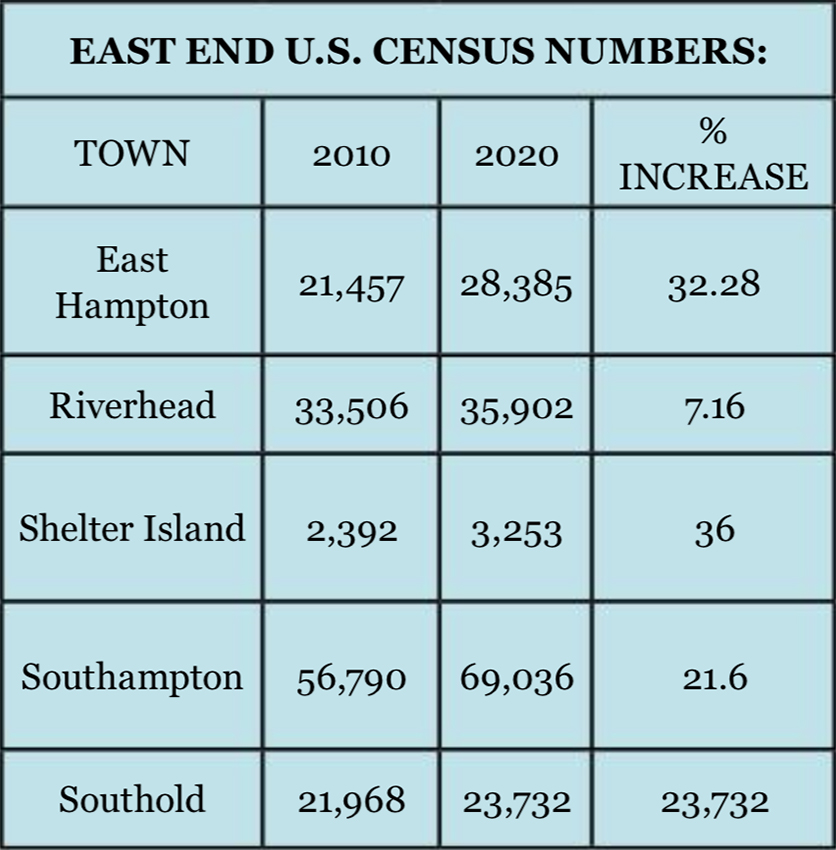2020 Census Reveals East End Population Shift

The U.S. Census data is in: From 2010 to 2020, the population of the five East End towns has grown by an average of more than 21%.
The Town of Shelter Island saw the biggest increase at 36%, but as the least populous town on the East End, that was the result of just 861 new residents, or the equivalent of Shelter Island Heights doubling. Seeing the smallest growth was the Town of Riverhead, which counted 2,396 additional residents — akin to a second Aquebogue moving in.
“I’m not surprised,” says Southampton Supervisor Jay Schneiderman, whose town population grew by 21.5% over the past decade. Noting that many people stayed in their “summer” homes beyond the summer season as New York City residents decamped to the Hamptons last year at the start of the coronavirus pandemic, Schneiderman says, “I think our effective population off-season for 2021 was probably over 100,000 people.”
By comparison, the U.S. population grew 7.4%, marking the smallest growth since the Great Depression and second smallest increase since the first census in 1790. New York State saw a 4.25% increase of 823,147 residents over the past decade. Long Island’s population grew 3.1% and Suffolk County’s grew by 2.2% — up 32,570, to 1.5 million.
One interesting trend that’s somewhat unique to Southampton, notes Schneiderman, is the makeup of the growing population.
“We’re one of the only communities on Long Island that actually increased the white population,” he says, adding, “We did have some increases in the Latino population, as well.”
The increase in white population in some East End communities bucks the national and island-wide trend of caucasians making up smaller slices of the population pie while minorities saw large gains.
During the pandemic, the number of people in town with greater disposable income went way up, which contributed considerably to the local economy, says Schneiderman. The abundant construction in Southampton is, for the most part, new homes replacing teardowns, he observes.

“This 20% jump can’t be based on new construction,” Schneiderman says. “It has to be based on more use of existing housing or, in some cases, a better count. Some of these people were here in 2010, but we made a much greater effort to get these people to respond to the census. I think some of the immigrant population had been undercounted in the 2010 census.”
More people in town translates to increased garbage, crime, wear and tear on roads and parks, and more town hires to service more requests, says Schneiderman.
“So, there’s definitely going to be a cost associated with it,” he says.
In East Hampton, the census reports 6,928 added residents — a 32% population increase — but the supervisor questions the accuracy of the findings.
“Obviously, they conducted it during COVID,” says East Hampton Supervisor Peter Van Scoyoc. “It was a time when there was quite a bit of fluctuation and population change. I think many of the people who ended up arriving here had probably already completed the census in another location and, therefore, were undercounted significantly.”
Once the COVID crisis passes, Van Scoyoc conjectures that some of these additional people residing in their summer homes might leave, while many others plan to stay.
“The nature of work has changed and people can work remotely, so I suspect we will have a significant increase in our year-round population,” Van Scoyoc says.
The influx of more people will impact East Hampton’s town budget, particularly because the tax base remains the same as demand for services rises.
In Montauk alone, the population rose from 3,326 to 3,685.
“Montauk’s been going through a lot of changes in the last several years, before the pandemic,” says Van Scoyoc. “It had become wildly popular, and we’ve seen the real estate prices shooting up and the availability of year-round rentals disappearing, compounding our housing crisis. I’m sure the trend has only gotten worse during COVID.”
Compared to the other eastern towns, Riverhead had a relatively small population increase, notes Riverhead Supervisor Yvette Aguiar.
“We had 7.2%,” says Aguiar. “Other towns have a much more substantial increase, such as Southold and Southampton.” Seeing a silver lining in increased numbers, Aguiar says, “Usually, when you have a higher census, whenever there’s funding and grants, you get a higher percentage of it, so, this will help us in that regard.”
Contending that the figures in his town are an undercount, Southold Supervisor Scott Russell avers that the number of residents whose primary residence is Southold will significantly impact the real estate market.
“There is such a demand on housing that the selling price for homes is unprecedented,” Russell says.
While more people in town will place a greater demand for services, the population growth is of such recent vintage that its impact is not readily discernible, Russell says.
“Southold has always been very seasonal anyway and there have always been increased demands on services and associated costs during the season,” adds Russell. “I’m sure we can absorb any new costs just fine.”
The 36% population surge on Shelter Island would have greater meaning if there were a breakdown of demographics of who is new to the island, says Shelter Island Councilman James Colligan.
“Are they people from the city that came out and decided to stay here and bring their families here?” Colligan asks. “Are they people who work here on the island that used to live off-island? Are these young couples? Are these retired people?
The implications might factor greatly into the Shelter Island school district,” notes Colligan.
“Because we’ve been on pretty much a steady decline in school population, it would be nice if young couples were here and enrolling their kids here,” he says. “That would be a big plus.”
Young people, in general, could potentially contribute to the fire department and EMS, whose volunteers are retiring as they age, and present new business opportunities on the island.
“I’m someone who believes in the strength of a diverse community,” says Colligan. “That’s in all ways: race, creed, color. And I also believe that it’s important to have people that could bring skills to the island that are needed here.”
-With Timothy Bolger




